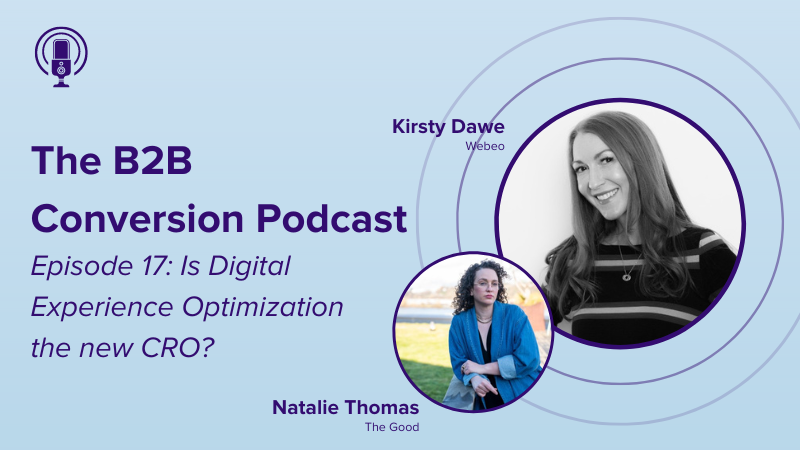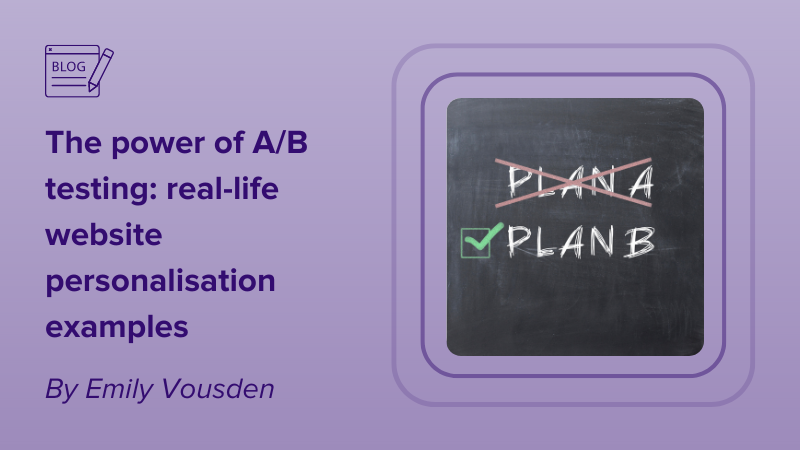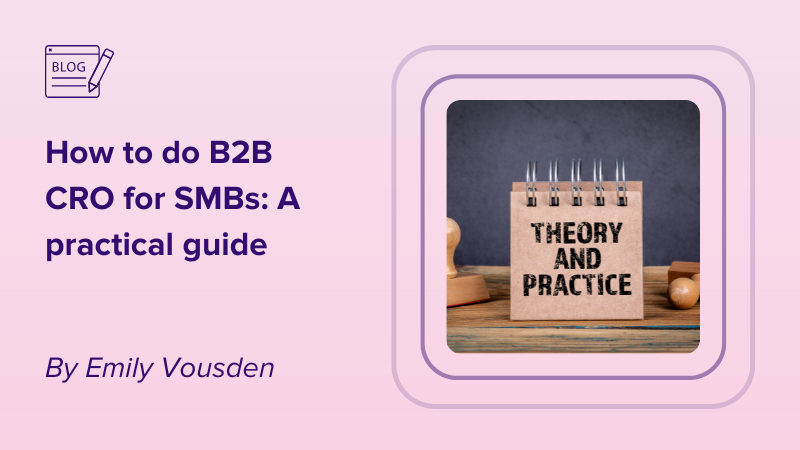There are very few B2B Marketers that don’t have personalization playing a key part within their marketing campaigns. Both marketing and sales professionals work tirelessly to make their messaging relevant to their various audiences. For that reason, B2B website personalization is somewhere on the agenda for most owners of demand generation-focused websites. But there is lots of variation in where it sits on the agenda. One of the most common reasons for when it is further down the agenda is a lack of content that is needed to create several variations of a single website, to appeal to different visitor segments.
There’s such a buzz around B2B website personalization that many marketers are mentally jumping from their current position (serving little to no website personalization) to a vision of the most impressive website personalization experience: Personalization Utopia. Whilst a great vision, the realization of what content is needed to facilitate that vision is daunting and causes action paralysis. Whilst wonderful, in reality the vision is simply overkill for what is actually needed to reap the rewards of B2B website personalization. All that ultimately matters is taking action on some very simple changes. That action will lead to more action, and once that’s in motion the rest will fall into place.
Let me set the scene…
At the turn of the year, I played golf with a couple of friends. I was keen to get their advice on my retirement planning as I recently turned 40, despite not looking a day over 39! His words were simple; The best day to start was yesterday, but the next best day is today, the most important thing is to simply take action. Action breeds more action, and you’re much more likely to find positive solutions when taking action than when procrastinating. Don’t worry about having the perfect strategy from day 1, just start taking action. You’ll figure the rest out as you go.
On the drive home from the golf course I thought about this advice. I recognized several other times when I’d let the daunting big picture of what was needed (or at least what I thought was needed) prevent me from taking action. Those times when I’d justified to myself why it will be better to start once I have more time, the weather is better, it gets lighter earlier – ultimately, I’ll wait until the perfect time arrives. But I couldn’t think of a single moment when the perfect time had arrived, they were always just excuses to justify procrastination. Sometimes there was some validity in the excuses, other times there wasn’t any validity at all! Either way, when I look back, every significant achievement or big task completed started with just taking action, and normally it was a small action that led to more.
(What a day, I’d only gone for a game of golf!)
What’s causing action paralysis for B2B marketers?
The same procrastination happens in business and people’s working lives. Across nearly 20 years in sales, countless times I’ve witnessed companies fail to take action due to waiting for the perfect time, which rarely ever comes. When they finally get started, all too often the “why didn’t we start sooner” hits. And the world of B2B website personalization isn’t any different.
Having spent many years selling the services of a B2B telemarketing agency, it’s refreshing now to be selling a solution that people genuinely get excited about. In 2 years of speaking with businesses about website personalization, and reviewing calls from my team, the vast majority of B2B marketers recognize the power of personalization and believe it will be part of their strategy. However, there’s a lot of variation in the anticipated timeline for when they will implement website personalization. There are two main reasons causing this variation.
The first is the current stage of the B2B website personalization market. Being several years in, with some weighty investments by high profile firms, many household marketing tech brands having website personalization add-on modules, and Webeo’s own customer base growing into the hundreds, the market is accelerating at a high pace. However, it’s still very much an early-stage market where the clientele can claim to be the innovators and early adopters. The chasm cross into the majority market is underway but not yet complete, meaning there is still much procrastination for the majority market. Pain avoidance is a more common decision factor than aspiration, meaning many in the majority market will only act when they feel they must because their competitors and peers are.
The second cause of variation in the timeline of companies’ getting started is being paralyzed by visions of Personalization Utopia. Website Personalization is simply making a user’s experience of your website more relevant to them. It’s saving the user from having to do the work to find the content they are after, or simply what is relevant to them. Do that and you will see improvements in dwell time, engagement, and conversion. Its success is born out of the basic human behavior that people engage better the more relevant an experience feels to them. It’s this undeniable logic that’s the reason so many B2B marketers see website personalization in their strategy. It’s also the reason so many have a vision of personalization perfection, where every single element of the website experience is entirely about the user, from the top of the first page to the bottom of the last page. People go from their current world where they serve no website personalization to a utopian vision, which is very exciting but the reality of making it happen is hugely daunting. The thought of what is required becomes so daunting it causes action paralysis.
Personalization Utopia is a noble idea, but the reality is that it is a ton of unnecessary work, if analyzed from a performance impact perspective. The Pareto principle plays a huge part in B2B website personalization; 80% of the uplift you can achieve will come from 20% of the changes you make.
So, what’s the 20%?
People don’t browse B2B demand gen websites for fun, they’re there for a reason. If a user bounces off a site quickly, or doesn’t convert in any way, there’s a high chance they’ve decided that they are in the wrong place. Google Research suggests that users’ first impressions are formed within just 50ms! No user has made it to the bottom of the home page in that time, let alone made it deeper into the site.
For those that are still with me and have investigated this research, I accept that this data is more linked to the design of the site than its content, so personalization won’t be playing a significant part at this stage (in layman’s terms, if your site design is ugly personalization isn’t going to save it!) A more relevant study in the B2B world was conducted by the Missouri University of Science and Technology, they found it takes only 2.6 seconds for a user’s eyes to land on the area of a website that most influences their first impression. However you cut it, users are making quick first impressions about your site and as Marketers know, first impressions are everything.
So, the 20% of actions that you can take that will deliver 80% of web performance uplift are changing what users see in those first seconds on your site. Ideally, your content above the fold on the landing page. Users aren’t reading your content and case studies within these initial seconds of their visit. Our 4 years of data on B2B website personalization performance reveals that main image, headline text, menu navigation, language and headline CTAs are the factors that make the immediate difference. These are simple changes you can make in a matter of minutes with a tool like Webeo. One of our SaaS clients that came on board last year immediately implemented our dynamic tag functionality in 4 places on their site (homepage, solutions page, pricing page and enquiry page). Simply adding @CompanyName and @Industry tags (which insert the company name and industry of the visiting business) delivered a 67% main site conversion uplift within the first 2 weeks! Nothing else was changed, created, or added. The homepage title went from Drive revenue to Drive revenue for @CompanyName, and it drove conversion for our client!
Getting started…
So don’t let a perceived lack of content stop you from reaping the rewards from B2B website personalization, nor the fear of not having the resource (the average Webeo customer spends less than 2 hours per month using the platform to achieve big performance gains). We are absolute believers in Personalization Utopia and see a day in the not-too-distant future when the entire web experience is customized to the user. But what’s important today is simply getting started, there are huge rewards to be gained from keeping things simple in the early days. And once you’re on your personalization journey, you will produce more great content quicker than you will if you don’t start the journey until the “perfect time” arrives.




